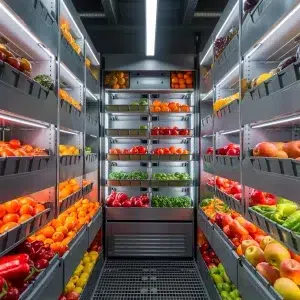Doors for supermarket cold stores
Food management in supermarkets
Supermarkets have large varieties of merchandise to store and retail that must be stored and maintained inside cold storage rooms for proper storage. Therefore, the quality, of cell and heat-insulating door, assumes paramount importance.
There are, of course, differences depending on the type of supermarket or cold logistics center, which depend on the size of the premises and the variety of food products that are offered, but where the type of storage is still the same.
The main issue, then, is to have different cells that can hold different types of product, and these, following both the standard and the various certifications, need environments that are sometimes completely different from each other.
Excluding the low-temperature cold line, which concerns frozen and deep-frozen, packaged or bulk foods, for which the cold rooms must necessarily be calibrated at a temperature between -18 and -25 degrees Celsius to prevent the start of the deterioration process of the product, all other foods have storage temperatures that are stably below +10 degrees Celsius but, and this is precisely the characteristic of supermarkets, these differ depending on the type of goods by only 2 to 3 degrees, which is essential for the constant maintenance of the products.
Food handling temperatures inside cold rooms in supermarkets.

In a supermarket there are also eggs and products, which tend to be fresh; these kinds of goods need a storage temperature that must be stably below 5°C. At the same temperature, which can be between 4 and 6°C, all cold cuts and milk with all its derivatives, including fresh cheeses, can be kept instead.
Regarding any type of meat (poultry, poultry, beef, pork) whether packaged or made available over the counter, it must be stored at 2°C. An exception should be made for fresh fish, for which it is preferable to keep the temperature just above freezing, between 1 and 2 °C.
Thus, it can be seen that cold storage is of fundamental value for the preservation of the cold chain and the optimal operation of the supermarket or logistics center, and where the organization with multiple cold rooms diversified by holding temperatures is indispensable.
The importance of pre-cells in supermarket cold storage.
Given also a flow, which tends to be considerable and a fast turnover of perishable goods, the majority of refrigeration areas of medium to large square footage will need to have a temperature-conditioned area (pre-cell), in front of the cold rooms or freezing chamber, used as disengagement and distribution, for rotation (incoming and outgoing) of goods.
This zone, which can be activated both on entry before storage and on exit when the goods are sent to the point of sale, also allows the handling of those foods that are normatively considered perishable such as those with coverings, such as filled desserts (specifically with fresh cream or custard made from eggs and milk) and yogurts in all types and formats.
The dedicated area, at a temperature set at 10/12 °C, will enable the staff to carry out inspection and placement operations more easily and quickly. Regular handling and placement on the sales shelves, forming the basis of proper cold chain management, will ensure the shelf-life (product life) within the minimum shelf life (MPT): the date by which the food product on the shelf retains its specific properties without any risk to the consumer's health.
Continuing down the path of preservation, cold rooms are needed within supermarkets and logistics centers to store and maintain products at temperatures below 0°C (LV Low Temperature). An example of negative-temperature storage is ice cream, which requires a temperature of -10 to -12 degrees Celsius, and frozen foods, which must be kept below 18 degrees Celsius by standard.
Semi-insulated storage doors for processing spaces in supermarket cold rooms.
Whatever the need of the store may be, as far as actual cold rooms are concerned, doors for positive temperature (Chiller) or negative temperature (Freezer) are available either pad-mounted, that is, swiveling on hinges, or sliding. In the presence of storage spaces, on the other hand, semi-insulating doors from MIV Insulating Systems (technical doors such as the Type Office and Come & Go models) allow optimization of temperatures in the various processing areas and thus significant energy savings. As for handling areas, moreover, Fast Roll and Fast Folding roll-up doors are the ideal solution for every type of operation and need, including highly customized ones.
Pre-cell door for cold stores Model Type Office
Pre-cell door for cold stores Model To and Fro


Contact information for supermarket cold store doors.
For further information write to us in our: contact form
Contact whatsapp: https://api.whatsapp.com/message/BWKLO7GYVGFDK1
Facebook link: https://www.facebook.com/mivrefrigeration
Linkedin link: Linkedin.com/company/mivinsulatingsystems
